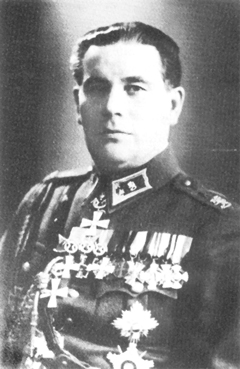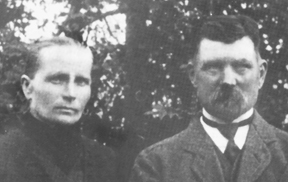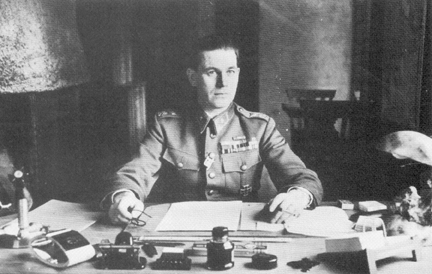Frans Uno Fagernas
The General from Terjärv, Finland
by Joelle Steele
 Frans Uno Fagernäs (1954)
Frans Uno Fagernäs (1954)
Frans Uno Fagernäs (born March 2, 1894 in Terjärv, Finland; died October 31, 1980) was known as Uno. He was born to Josefina “Fina” Mattsdotter Bredbacka (born February 16, 1862; died December 29, 1933) and Anders Simonsson Fagernäs (born September 5, 1857; died March 10, 1932). They were married on June 25, 1887. In addition to Uno, they had ten children: Anders Teodor, Anna Cecilia, Karl Ture, Matts Fridolf, Josefina Hildegard, Väinö Johannes, Gerda Matilda, Gerhard Olof Immanuel, Verner Osvald, and Hjördis Elvi Elisabeth.
Uno also had a half-sister from his father’s first marriage to Maria Charlotta Kankkonen: Maria Alexandra Andersdotter (08/16/1884-01/31/1886). She died young, just a month before her mother died.
Uno was a descendant of Ragvald Koiraniemi, the progenitor of the Caino-Torp ancestral line which has produced many talented and influential people. Uno shares this heritage with Ray Dolby, Johan Ludwig Runeberg, Tapio Wirkkala, and me – Ragvald is my 14th great-grandfather, and Uno is my first cousin twice removed (1C2R).
All of Uno’s siblings were musical, and his brothers could discuss and debate and draw logical conclusions. The same was true of his sisters Hjördis and Hilda, but not as much for his sisters Anna and Gerda, who were quieter and didn’t participate much in conversation.
Uno's mother, Fina, was considered to be the most beautiful of her sisters. She was talented, but unfortunately could not get education beyond that which the local church-based school had to offer. She had a strong will, but when it came to marriage, she didn't get to marry the "poor" farmer she had chosen. Instead, her mother demanded that she marry Anders, who was a "rich" widowed farmer. While Fina doubted the marriage at first, it turned out to be a happy one. Anders was a talented man who played the organ in church.
 Fina and Anders Fagernäs
Fina and Anders Fagernäs
Uno's biographer, his half-fourth cousin twice removed (½-4C2R), Helge Evald Mathias Smedjebacka (03/22/1926-01/13/1997), wrote in his 1993 book Generalen från Terjärv (The General from Terjärv) that Anders and Fina "were one of the richest families in the area. They wanted to be cultured people, and most of their kids were cultured and talented but had no opportunities for advanced studies." How they were considered to be rich yet their kids lacked opportunities for advanced studies seems to be a contradiction, unless they were just not quite "rich" enough to provide those opportunities for so many children somewhere outside of the small town of Terjärv.
While his father may have been a "rich" farmer, Uno wrote of his parents, "From my father's and mother's sides of the family I've got real farmer's blood in my veins. There's no fancy blue blood in my family tree."
On July 27, 1920, at the age of 26, Uno married his cousin, Agnes Valborg Berg (04/25/1899-?), the daughter of his uncle, Karl Johan Berg, his mother's brother. Agnes and Uno were the parents of three children: Karl Uno Torleif "Ture" (06/26/1921-?).2); Ole Gustav Adolf (10/22/1926-?); and Harriet Agneta Maria (07/19/1930-?).
Uno attended school in Jakobstad. He said, "I had to leave my dear homeland to continue my schooling in Jakobstad. I had to grapple with new curriculum materials, with Finnish and French, English and Russian, logarithms and evolution."
Uno had wanted to study medicine, but on February 25, 1915, he and his cousin, Martin Rafael Berg (06/07/1894-), along with 55 others, registered at the Lockstedter Lager training area in northern Germany, where they received military training along with others from Terjärv. Uno was later assigned to the first company of the Royal Prussian Jaeger Battalion 27. During World War I, his battalion was posted to the German Eastern Front to get combat experience fighting on the Misse River in the Gulf of Riga and the Aa river. In 1917, he completed the "A" course of the military school in Libau (at that time the westernmost city of the Russian Empire).
While in the Jaegers, Uno was called to action in 1918. Many were promoted to officers in the autonomous Finnish army while they were still on German soil. Uno was promoted on February 25, 1918 to company commander and battalion commander. It was difficult to integrate the hunter guards into the Finnish army since they had previously served in the Imperial Russian Army too. Uno was in the top company of the Parachute Regiment, Second Battalion. His first major battle was at Lempäälä, söderom Tampere.
Uno became a well-known military leader during the Russian-Finnish wars and during World War II. While a lieutenant in charge of the poorly-equipped and inexperienced 64th Infantry Regiment, he played a role in the Motti Battles of the Winter War which began in late November 1939 when Russian forces invaded Finland after demanding and being refused certain strategic territorial cessions.
 Frans Uno Fagernäs at his desk during World War II
Frans Uno Fagernäs at his desk during World War II
On April 4, 1940, Uno was promoted to Colonel. A little over a year after the end of the Winter War, the Continuation War (1941-1944) began. It was a part of World War II in Finland, and was also known as the Second Soviet-Finnish War. Finland and Nazi Germany fought against Russia, and Uno commanded Group F in Louhi in Karelia and then commanded the first division on the Maaselkä isthmus in northeast Karelia where he led battles from Karhumäki to Tolvajärvi and stopped the Russian advance. On November 16, 1942, Uno was again promoted, this time to Major-General.
Uno was awarded the German War Merit Cross Second Class, for bravery in the field during World War II. In 1957, a new version of that medal replaced the swastika with the date "1939." He was also awarded the Commander First Class of the White Rose of Finland. And also the Mannerheim Cross of Liberty First Class, the most distinguished Finnish military honor given for exceptional bravery, for crucially important objectives by combat, and for especially successfully conducted operations. It has not been awarded since 1945.
After World War II, Uno became a military county commander until 1954, at which time he retired. He was the only Swedish-speaking general from Ostrobothnia during World War II. During his retirement, he served as the honorary chairman of reserve officers clubs in Vaasa and Pietarsaari, and was a board member of the Freedom Fighters Maintenance Foundation.

